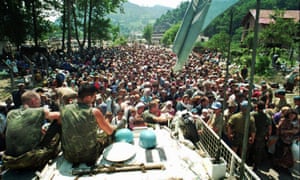'Srebrenica massacre: Dutch soldiers let 300 Muslims die, court rules
UN peacekeepers should have known men were in danger, appeals court in The Hague rules over 1995 mass killing in Bosnia
Dutch soldiers acting as UN peacekeepers were partly liable for the deaths of about 300 Muslim men massacred near Srebrenica in Bosnia and Herzegovina during the Yugoslavian civil war, an appeals court in The Hague has ruled.
The ruling upholds a decision three years ago that the Dutch forces should have known that the men seeking refuge at their base would be murdered by Bosnian Serb troops if they were turned away.
Many of the victims had fled to Srebrenica’s UN-designated safe zone only to find themselves outnumbered and the lightly-armed Dutch troops unable to defend them. It was then that they headed to the nearby Dutch base, only to be subsequently handed over to their murderers.
Presiding judge Gepke Dulek-Schermers said that Dutch soldiers “knew or should have known that the men were not only being screened … but were in real danger of being subjected to torture or execution … by having the men leave the compound unreservedly, they were deprived of a chance of survival”.
The judge added that the soldiers had facilitated the separation of the men and the boys among the refugees.
The ruling came as a lawyer for 200 Dutch army veterans said his clients planned to sue the state for compensation for the trauma they suffered after being sent on “an impossible mission” in Srebrenica.
Michael Ruperti said the men are campaigning for a “symbolic” €22,000 (£19,500) each – or €1,000 for every year since the massacre took place, bringing the value of the total suit to €4.5m.
The 200 soldiers were serving in the Dutch battalion Dutchbat III protecting the Muslim enclave when it was over-run by Bosnian Serbs under the command of former general Ratko Mladić .
About 8,000 Muslim men and boys in total were killed by Bosnian Serb troops in Srebrenica in July 1995, in what is believed to be the worst mass killing on European soil since the second world war.
The ruling in the appeals court relates specifically to the 300 men who had sought safety on the Dutch-controlled base.
The amount of damages will be determined in a separate procedure unless the victims and the state can reach a settlement.
The Dutch government resigned in 2002 after acknowledging its failure to protect the refugees. The Netherlands maintains that the Bosnian Serbs, not Dutch troops, bear responsibility for the killings.
Mladić is on trial for genocide with a verdict expected later this year. The court rejected an appeal from relatives of other Srebrenica victims, who argued the Dutch government should be held responsible for the protection of thousands more Muslims who had gathered outside the base.
Munira Subasic, of the Mothers of Srebrenica group, said: “This is a great injustice. The Dutch state should take its responsibility for our victims because they could have kept them all safe on the Dutchbat [Dutch battalions’] compound.”'



